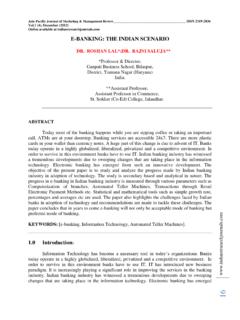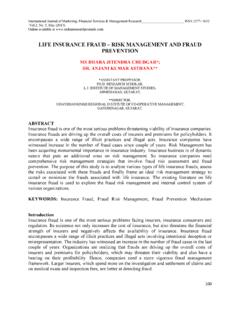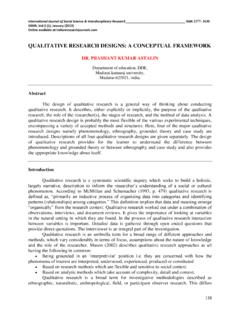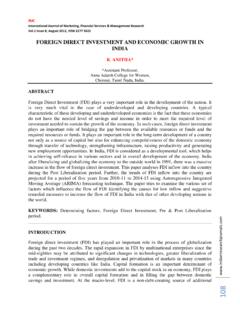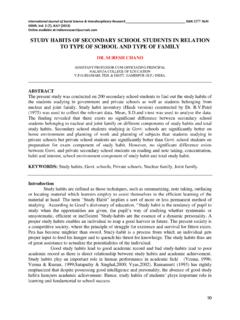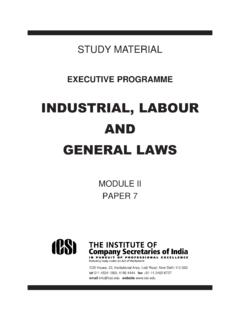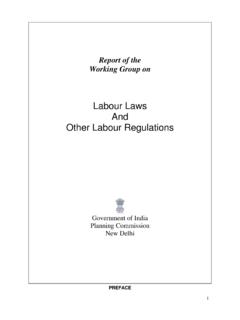Transcription of IMPLEMENTATION CHILD LABOUR LAWS: …
1 Asia Pacific Journal of Marketing & Management Review_____ ISSN 2319-2836 (9), September (2013) Online available at 83 IMPLEMENTATION CHILD LABOUR laws : OBSTCLES AND EFFORTS ASSISTANT PROFESSOR IN PUBLIC ADMINISTRATION, SHAH SATNAM JI GIRLS P. G. COLLEGE, SIRSA ABSTRACT The problem of CHILD LABOUR has been more serious in developing countries. Due poverty, hunger, illiteracy, ignorance, traditional thinking and lack of proper IMPLEMENTATION of CHILD LABOUR laws in our country ,the problem of CHILD LABOUR is still persist in our society.
2 The children of age below 14 years have working in various fields and in very hazardous conditions. The number of CHILD LABOUR has been increasing in our country and the number of CHILD LABOUR is more in our country as compared to any other country in the world. Many provisions are provided in our constitution and in laws to control CHILD LABOUR but socio-economic conditions prevalent in the country do not force children to get compulsory education and to enjoy right to education. The attempt has been made in this paper to provide brief account of CHILD LABOUR laws in our country, reasons for CHILD LABOUR and suggestions to control CHILD LABOUR . _____ In developing countries it is impossible to control CHILD LABOUR as children have been considered as helping hand to feed their families, to support their families and to feed themselves.
3 Due to poverty, illiteracy and unemployment parents are unable to bear the burden of feeding their children and to run their families. So, poor parents send their children for work in inhuman conditions at lower wages. The CHILD LABOUR lead to underdevelopment, incomplete mental and physical development, which in turn results in retarded growth of children. Due to lack of proper IMPLEMENTATION of CHILD LABOUR laws , improper IMPLEMENTATION of CHILD welfare plans and improper checks by department of women and CHILD welfare, the problem of CHILD LABOUR has been still persisting in our society in urban as well as in rural areas. Children in our country work as rag pickers, dish washers in dabhas, as labourers in small factories, as domestic helpers in big cities.
4 india has largest number of children employed than any other country in the world. Around 90 million out of 179 million children in the age group of 6-14 year do not go to school and are engaged in some occupation or other so around 50 percent of children of our country are involved in CHILD LABOUR . A large numbers of children are engaged in cottage industries: carpet, matches, firecrackers, bidis, brassware, diamond, glass, and hosiery, hand loomed cloth, leather goods, plastic, bangles, sporting goods, at shops as helpers. CHILD LABOUR laws IN india Various laws have been made in our country since 1933 to control CHILD LABOUR : 1. Children (Pledging of LABOUR ) Act 1933. 2. Employment of CHILD Act 1938. 3.
5 The Bombay shop and establishment Act 1948. 4. The Indian factories Act 1948. Asia Pacific Journal of Marketing & Management Review_____ ISSN 2319-2836 (9), September (2013) Online available at 84 5. Plantation LABOUR Act 1951. 6. The mines Act 1952. 7. Merchant shipping Act 1958 8. The apprentice Act 1961 9. The motor transport workers Act 1961 10. The atomic energy Act 1962 11. Bidi and cigar workers (condition of employment) Act 1966. 12. State shops and establishment Act 13. The CHILD LABOUR (Prohibition and Regulation) Act 1986. 14. The juvenile justice (care and protection) of children Act, 2000. 15. Article 24 of our constitution and section 67 of the factories Act, explicitly direct that children below the age of 14 years are not allowed to work in factories.
6 16. Article 21A (added by the 86th amendment Act 2002) provides that state shall provide free and compulsory education to children of age group 6-14 years. 17. Article 45 provides for free and compulsory education for all children up to the age of 14 years1. EFFORTS BY GOVERNMENT OF india TO CONTROL CHILD LABOUR The CHILD LABOUR (Prohibition and Regulation) Act 1986 prohibits the employment of children below the age of 14 years in 16 occupation and 65 processes that are hazardous to the children s lives and health. According to Supreme Court s direction on 10th December, 1996, recovery notice have been issued to offending employees for collection of a sum of Rs 2000 per CHILD employed under the provision of Act. No CHILD can be employed in hazardous occupations.
7 Many states including Haryana have constituted the CHILD LABOUR rehabilitation cum-welfare funds at district level and separate LABOUR cells are being formed to address the issue2. National CHILD LABOUR projects have been implemented by the central government in states from 1988 to provide non-formal education and pre-vocational skills. From 2001, Sarve shiksha Abhiyan has been launched to educate poor and employed children in all states. Ministry of women and CHILD development has been providing non-formal education and vocational training. Establishment of Anganbadies is also a big step by the government for the welfare of children and their physical, mental and educational development.
8 CHILD LABOUR STASTICES IN HARYANA In Haryana according to census there has been 131 percent increase in the incidence of CHILD LABOUR during 2001 as compared to 19913. Year no. of CHILD labourers 1991 1,09,691 2001 2,53,491 Asia Pacific Journal of Marketing & Management Review_____ ISSN 2319-2836 (9), September (2013) Online available at 85 CHILD LABOUR in Haryana Owing to typical problems of poverty and social insensitivity to the employment of children, the problem of CHILD LABOUR continues to exist in the State. However, the problem is not endemic. It is virtually non-existent in the prohibited hazardous occupations. The CHILD LABOUR in the State is generally found in the establishments of dhabas, tea-stalls, restaurants and automobile repair workshops etc.
9 It has been the endeavour of the Haryana Government to bring about optimal development of children by providing them nutrition, health care, education, general, physical and emotional support. It has been striving for the achievement of these goals in accordance with the duties assigned by the constitution of india in Article 39 (e)(f), 45 and especially so under Article 24 regarding prohibition of employment of Children. Haryana State has also prepared a 'State Plan of Action' for the children which is a very comprehensive document encompassing the various critical areas like health, nutrition, education and environment with issues like girl CHILD , CHILD LABOUR and children especially in difficult circumstances.
10 A ' CHILD LABOUR Cell' at headquarters has been constituted to pay special attention towards elimination of CHILD LABOUR . The Cell is headed by a Joint LABOUR Commissioner. Moreover, the necessary directions have been issued to the Inspectorate staff to ensure that working hours of such children do not exceed six hours. The other State Government departments which are involved in the task of rehabilitation of CHILD LABOUR are Health, Education and Social Welfare departments. The Health department has been instructed to get the CHILD LABOUR medically examined and issue health cards in the districts. The Project Director, Sarv Shiksha Abhiyan and Director, Primary Education have also been requested to enrol the CHILD LABOUR in schools.
